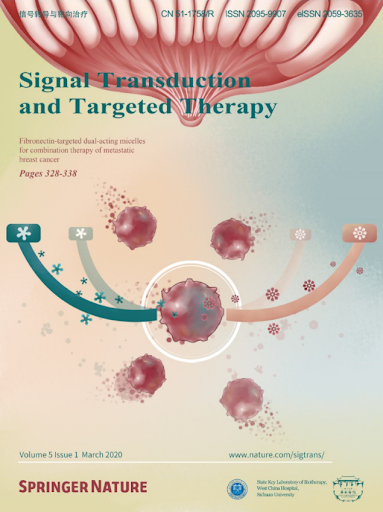Anti-BCL2 therapy eliminates giant congenital melanocytic nevus by senolytic and immune induction.
IF 52.7
1区 医学
Q1 BIOCHEMISTRY & MOLECULAR BIOLOGY
引用次数: 0
Abstract
Giant congenital melanocytic nevus (GCMN) is a RAS/RAF mutation-driven syndrome characterized by extensive melanocytic lesions, posing psychological challenges and a lifelong risk of malignancy. Existing treatments like surgical resection and laser therapy fail to fully remove lesions, and MAPK inhibitors show limited efficacy. This study identified a predominant population of senescent cells and a minority of proliferative cells in GCMN, necessitating dual-targeted strategies. We found that the anti-apoptotic protein BCL2 is expressed in both senescent and proliferative cells from GCMN patients with various gene mutations. Coexpression of P16 and BCL2 indicated a phenotype of growth arrest and cell survival. BCL2 inhibitors (BCL2i) showed significant cytotoxicity to GCMN cells in vitro. Hypopigmentation and GCMN cell clearance were observed in patient-derived xenograft models and in NrasQ61K-mutated and BrafV600E-mutated transgenic models following BCL2i treatment. Histology of regressed GCMN indicated extensive immune cell infiltration, suggesting immune involvement. Single-cell sequencing and immunostaining revealed that activated neutrophils formed extracellular traps, synergizing with BCL2i to treat GCMN. Neutrophil depletion and immunosuppression reduce treatment efficacy, highlighting the crucial role of the immune response post-BCL2i treatment. Long-term follow-up showed no recurrence, with neutrophils and T cells residing in the dermis, indicating memory immune reactions. These findings present a promising therapeutic strategy and underscore the translational potential of BCL2i in treating GCMN.抗bcl2治疗通过衰老和免疫诱导消除巨大的先天性黑素细胞痣。
巨大先天性黑素细胞痣(GCMN)是一种RAS/RAF突变驱动的综合征,其特征是广泛的黑素细胞病变,带来心理挑战和终身恶性肿瘤风险。现有的治疗方法如手术切除和激光治疗不能完全去除病变,MAPK抑制剂的疗效有限。本研究确定了GCMN中主要的衰老细胞和少数增殖细胞,需要双靶向策略。我们发现抗凋亡蛋白BCL2在各种基因突变的GCMN患者的衰老细胞和增殖细胞中均有表达。P16和BCL2的共表达表明了生长停滞和细胞存活的表型。BCL2抑制剂(BCL2i)对体外GCMN细胞有明显的细胞毒性。在BCL2i治疗后,患者来源的异种移植物模型以及nrasq61k突变和brafv600e突变的转基因模型中观察到色素沉着降低和GCMN细胞清除。退化的GCMN组织学显示广泛的免疫细胞浸润,提示免疫受累。单细胞测序和免疫染色显示,活化的中性粒细胞形成细胞外陷阱,与BCL2i协同治疗GCMN。中性粒细胞耗竭和免疫抑制降低了治疗效果,突出了bcl2i治疗后免疫反应的关键作用。长期随访未见复发,中性粒细胞和T细胞驻留在真皮中,提示记忆免疫反应。这些发现提出了一个有希望的治疗策略,并强调了BCL2i在治疗GCMN中的转化潜力。
本文章由计算机程序翻译,如有差异,请以英文原文为准。
求助全文
约1分钟内获得全文
求助全文
来源期刊

Signal Transduction and Targeted Therapy
Biochemistry, Genetics and Molecular Biology-Genetics
CiteScore
44.50
自引率
1.50%
发文量
384
审稿时长
5 weeks
期刊介绍:
Signal Transduction and Targeted Therapy is an open access journal that focuses on timely publication of cutting-edge discoveries and advancements in basic science and clinical research related to signal transduction and targeted therapy.
Scope: The journal covers research on major human diseases, including, but not limited to:
Cancer,Cardiovascular diseases,Autoimmune diseases,Nervous system diseases.
 求助内容:
求助内容: 应助结果提醒方式:
应助结果提醒方式:


